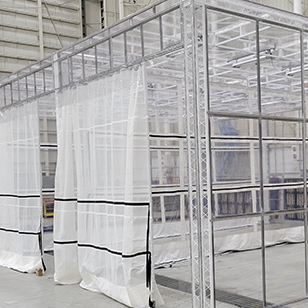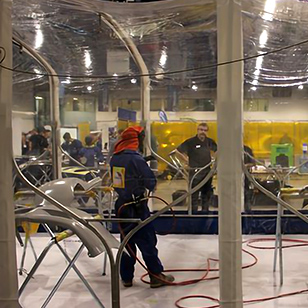Clean Air Solutions Designed for 3D Printing and Additive Manufacturing Processes
3D printing and additive manufacturing are big growth areas for aerospace manufacturers that are seeking to radically reduce the number of parts, complexity of design and assembly, reduce costs, save time, and increase the scale of production.
But the clean air and health-related impacts of 3D printing and additive manufacturing processes are still somewhat undetermined. Chemical Insights, an institute of Underwriters Laboratories, worked with Georgia Institute of Technology to study possible impacts on air quality. They found health concerns are especially noteworthy when 3D printers are used in large industrial spaces with multiple print units in operation and insufficient ventilation control.
The research shows that 3D printing and additive manufacturing generate ultrafine particles (UFPs) and numerous volatile organic compounds (VOCs) that may affect human health.
The good news is that flexible industrial air filtration systems already exist to bring clean air to additive manufacturing work spaces.
3D Printing and Additive Manufacturing Show Great Promise
With additive manufacturing, if a manufacturer wants to make a new part, or make significant design changes, it can be done with a few software and configuration changes as opposed to a more elaborate retooling process for traditional manufacturing.
In fact, rocket manufacturer Relativity Space, which is 3D printing an entire rocket, credits its 3D metal printers with:
- Faster design iterations and part optimizations
- Real-time quality control and part inspection
- Sensor and analytics-driven machine learning
Aerospace manufacturers, including NASA, have long been intrigued by the promise of 3D printing and additive manufacturing, and many have used the technology for rapid prototyping and proof of concept. 3D printing and additive manufacturing are beginning to take hold and will eventually be used in commercial and large scale manufacturing.
The topic of additive manufacturing will again be front and center at the AeroDef 2021 Manufacturing conference in September.
3D, Additive Manufacturing Processes Produce Dangerous Particles
The manufacturing processes for 3D printing with metals often involve direct metal laser sintering, in which a laser fuses together particles of metal powder, creating the required structure layer by layer. This and other similar processes such as selective laser sintering, selective laser melting, and direct metal laser melting, also produce ultra-fine particles (UFPs), which can be inhaled. UFPs can penetrate deep into the human pulmonary system and trigger lung irritation, respiratory and chest discomfort, and asthma. Long-term exposure may lead to respiratory and cardiovascular diseases.
3D printing and additive manufacturing processes also involve melting plastic, which releases VOCs into the air. VOC exposure can result in headaches, eye and nose irritation, and flu-like symptoms.
A recent study from NIOSH showed there are numerous inhalation risks produced by a variety of additive manufacturing processes, including:
- Material extrusion, involving electrical heating element-induced melting and cooling
- Powder bed fusion, involving high-powered laser or electron beam heating
- Vat photopolymerization, involving ultraviolet-laser induced curing
Duroair’s Patented Solutions Address 3D Printing UFPs and VOCs
Manufacturers are well familiar with VOC risks, and there are proactive industrial air filtration solutions to filter and destroy potentially toxic VOCs. Duroair’s clean air solutions also address the UFPs and other particulates generated by 3D printing and additive manufacturing processes. In fact, Duroair’s patented clean air solutions create indoor environments that are so clean, they exceed OSHA requirements.
Coupled with a modular enclosure that can be custom-tailored for even large-scale 3D printing processes, Duroair industrial air filtration efficiently removes airborne hazards and recirculates air back into the enclosure. Additional benefits include:
- Allows additive manufacturing processes to be moved when and where needed, without interrupting other cellular workflows
- Prevents contamination from corrosive dust and hazardous fumes that can threaten 3D printing integrity and quality
- Retracts as needed to allow crane access and won’t interfere with current ventilation infrastructure
Duroair’s Taper Draft Airflow Technology uses downdraft airflow to bring air particulates down away from employees and collect all toxic VOCs via multi-stage filtration. It also provides protection for 3D printing integrity and quality, without contamination from corrosive dust and hazardous fumes.
Retractable Enclosures Meet 3D Printing and Additive Manufacturing Needs
Duroair can engineer industrial air filtration systems for specific 3D printing and additive manufacturing processes. Armed with this technology, aerospace manufacturers can use 3D printing to innovate, without exposing facility employees to dust and gaseous particulates that can threaten safety and productivity.
Duroair’s retractable clean air booths are among the most flexible industrial clean-air solutions in the marketplace. Our experts can show you how we can create the most flexible solution possible to:
- Increase operational efficiency.
- Find agile ways to safeguard critical tasks.
- Reduce downtime.
- Safeguard products without impacting productivity.
- Ensure employee safety.
- Meet all compliance requirements.
Contact our industrial clean air experts today for a free consultation.

